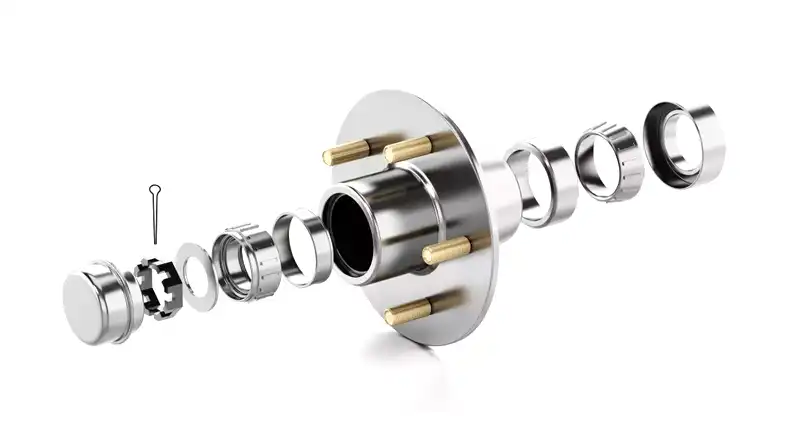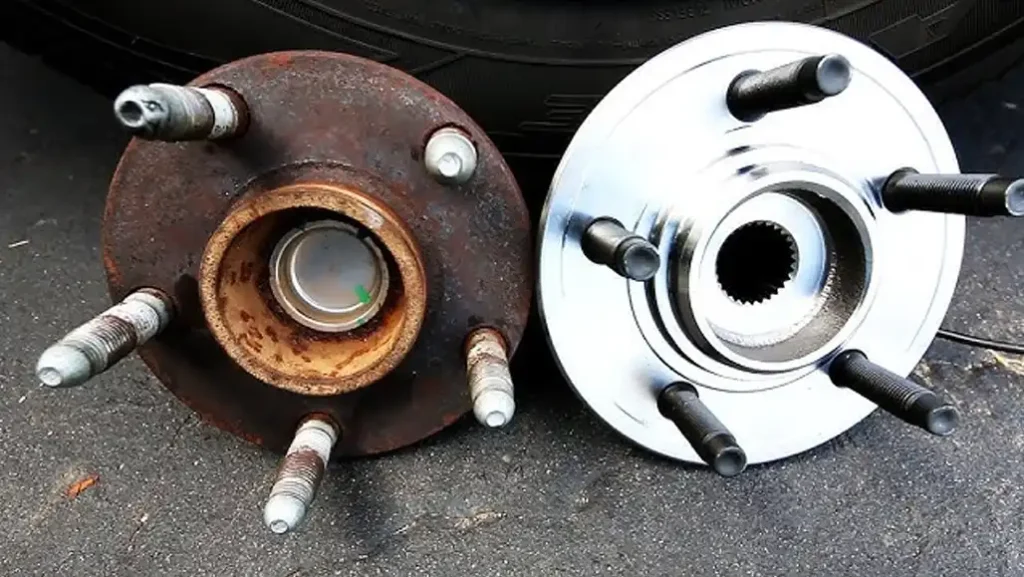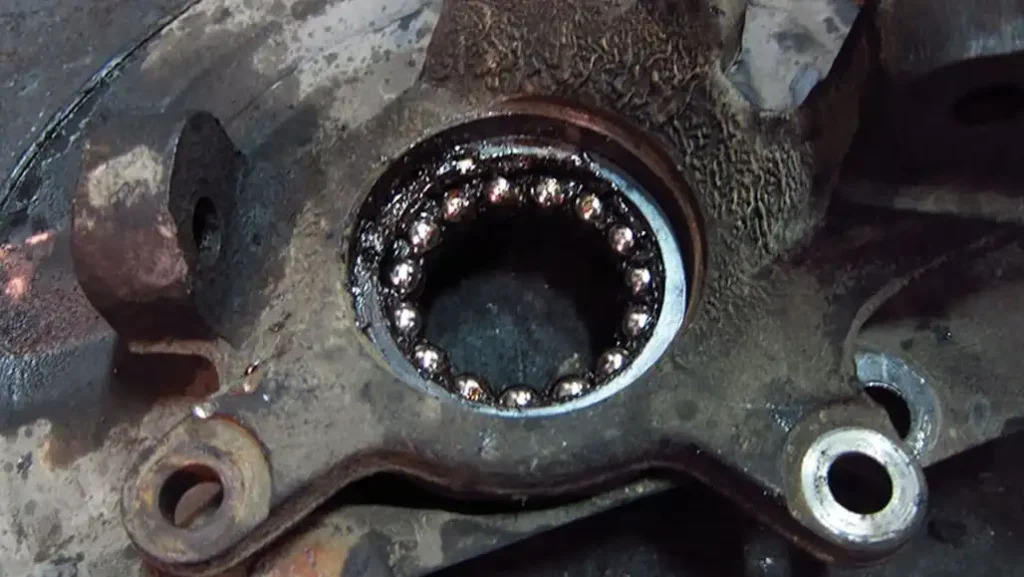Driving smoothly relies on various components of your vehicle working seamlessly together. One crucial element often overlooked until issues arise is the wheel bearing.
But what does a bad wheel bearing sound like? Identifying these sounds early can save you from costly repairs and potentially hazardous driving situations.
What Are Wheel Bearings?

Wheel bearings are essential components of a vehicle’s wheel assembly that facilitate smooth and friction-free rotation of the wheels. They play a crucial role in supporting the weight of the vehicle and allowing the wheels to spin freely while minimizing friction and heat buildup.
Essentially, wheel bearings consist of small steel balls or rollers housed within a metal ring called a race. These balls or rollers are arranged in a specific pattern within the race to distribute the load evenly and reduce friction as the wheel rotates.
The primary function of wheel bearings is to enable the wheels to rotate smoothly with minimal resistance, even under heavy loads and varying driving conditions. This smooth rotation is vital for maintaining vehicle stability, steering control, and overall driving comfort.
Wheel bearings are located within the hub assembly, which is typically mounted between the brake rotor or drum and the axle shaft. They are subjected to constant stress and wear due to the weight of the vehicle and the forces generated during braking, acceleration, and cornering.
Proper lubrication is crucial for the smooth operation and longevity of wheel bearings. Grease or lubricating oil is used to reduce friction between the bearing components, preventing metal-on-metal contact and minimizing wear.
What Does a Bad Wheel Bearing Sound Like?

If you’re wondering what a bad wheel bearing sounds like, it’s important to listen for certain distinctive noises that can indicate potential issues with your vehicle’s wheel bearings.
Here are some common sounds associated with bad wheel bearings:
- Grinding or Growling Noise: One of the most recognizable signs of a bad wheel bearing is a grinding or growling noise, often heard when driving at higher speeds or during acceleration or deceleration. This noise resembles metal grinding against metal and can indicate significant wear on the bearing.
- Clicking or Snapping Sounds: When turning or maneuvering your vehicle, you may notice clicking or snapping sounds coming from the wheel area. These noises can occur as the bearing’s balls or rollers become worn or damaged, causing them to shift within the race.
- Humming or Whirring Sound: A constant humming or whirring noise, particularly noticeable at higher speeds, may indicate a failing wheel bearing. This noise is often likened to the sound of an airplane taking off and can become louder as you accelerate.
- Uneven Tire Wear: Experiencing uneven tire wear, especially on one side of the vehicle, could be a consequence of a bad wheel bearing. A failing bearing may cause excessive friction on the affected wheel, leading to irregular tire wear patterns.
- Steering Wheel Vibration: Vibrations in the steering wheel, particularly at higher speeds, may be a sign of wheel bearing issues. These vibrations can affect the overall stability of your vehicle and may be accompanied by a slight wobble in the steering wheel.
- ABS Warning Light: A malfunctioning wheel bearing can trigger your vehicle’s anti-lock braking system (ABS) warning light. If the sensor detects irregular wheel speed due to a faulty bearing, the ABS warning light may illuminate on your dashboard.
- Wheel Play or Looseness: During vehicle inspection or when the wheel is lifted off the ground, you may notice excessive wheel play or looseness. Gently rocking the wheel back and forth may reveal abnormal movement, indicating a compromised wheel bearing.
These are some of the key sounds associated with bad wheel bearings. If you notice any of these noises while driving, it’s essential to have your vehicle inspected by a qualified mechanic to address any potential issues promptly. Ignoring wheel bearing problems can lead to further damage and compromise your safety on the road.
What Does a Bad Wheel Bearing Look Like

How to tell if wheel bearing is bad?
Identifying a bad wheel bearing typically involves visual inspection and recognizing specific signs of wear or damage. While wheel bearings are internal components housed within the wheel hub assembly, there are external indicators that can suggest a problem. Here’s what a bad wheel bearing might look like:
- Visible Damage: Inspect the wheel hub assembly for any visible signs of damage or wear. This could include cracks, pitting, or corrosion on the surface of the hub or around the bearing area.
- Excessive Play: Attempt to wiggle the wheel back and forth while the vehicle is jacked up. Excessive play or looseness in the wheel indicates that the wheel bearing may be worn or damaged.
- Abnormal Noise: While driving, listen for unusual noises coming from the wheel area, such as grinding, growling, clicking, or humming sounds. These noises can indicate worn or damaged wheel bearings.
- Uneven Tire Wear: Inspect the tires for uneven wear patterns, especially on one side of the vehicle. Uneven tire wear can be a sign of a bad wheel bearing causing excessive friction on the affected wheel.
- ABS Warning Light: If the anti-lock braking system (ABS) warning light illuminates on the dashboard, it could indicate irregular wheel speed caused by a faulty wheel bearing.
- Heat Buildup: After driving, carefully touch the wheel hub assembly to check for excessive heat buildup. Overheating can occur due to friction caused by a bad wheel bearing.
- Visible Grease Leakage: Check for any signs of grease leakage around the wheel hub assembly. Grease leakage can indicate a damaged wheel bearing seal or insufficient lubrication.
- Wheel Alignment Issues: A bad wheel bearing can affect the alignment of the wheels, leading to steering drift or pulling to one side while driving.
What Causes Wheel Bearings to Go Bad

What causes a wheel bearing to go bad?
Several factors can contribute to the deterioration of wheel bearings, leading to their failure. Understanding these causes can help vehicle owners take preventive measures and address issues promptly.
Here are some common reasons why wheel bearings go bad:
- Lack of Lubrication: Adequate lubrication is essential for reducing friction and wear between the bearing components. Over time, if the lubricant breaks down or becomes contaminated with dirt and debris, it can lead to increased friction and premature wear of the bearing surfaces.
- Excessive Heat: High temperatures generated during prolonged driving, especially under heavy loads or in hot weather conditions, can cause the lubricating grease inside the wheel bearings to break down. This can result in inadequate lubrication and accelerated wear of the bearing components.
- Water Contamination: Exposure to water, particularly through driving in wet or flooded conditions, can infiltrate the wheel bearings and contaminate the lubricant. Water contamination can accelerate corrosion of the bearing surfaces and lead to premature failure.
- Improper Installation: Incorrect installation of wheel bearings, such as improper torque settings or inadequate lubrication during assembly, can compromise their integrity and lifespan. It’s essential to follow manufacturer guidelines and specifications when installing wheel bearings to ensure proper function and longevity.
- Heavy Loads: Excessive weight or overloading of the vehicle can put additional stress on the wheel bearings, leading to premature wear and failure. Properly distributing the load and avoiding exceeding the vehicle’s weight limits can help mitigate this issue.
- Impact Damage: Rough road conditions, potholes, or collisions can subject the wheel bearings to impact forces, causing damage to the bearing surfaces or the bearing assembly. Even a single significant impact can lead to premature wear and eventual failure of the wheel bearings.
- Age and Mileage: Like many mechanical components, wheel bearings are subject to wear and degradation over time, especially with high mileage vehicles. Aging bearings may develop cracks, pitting, or other defects that compromise their structural integrity and performance.
- Poor Maintenance: Neglecting regular maintenance, such as failing to inspect and grease the wheel bearings as recommended by the manufacturer, can accelerate wear and deterioration. Routine maintenance tasks can help detect issues early and prevent costly repairs down the line.
Addressing these potential causes and practicing proactive maintenance can help prolong the lifespan of wheel bearings and ensure safe and reliable operation of the vehicle. Regular inspections, timely repairs, and proper lubrication are essential for preserving the integrity and performance of wheel bearings.
Signs of a Bad Wheel Bearing

How to diagnose a bad wheel bearing?
Recognizing the signs of a failing wheel bearing is essential for maintaining your vehicle’s safety and performance. Here are seven common indications to watch out for:
1. Growling or Grinding Noise
A growling or grinding noise coming from the wheel area, especially during acceleration or deceleration, is a classic sign of a bad wheel bearing.
Description:
You may notice a deep, rumbling noise resembling metal grinding against metal, indicating significant wear on the bearing.
Example:
“When driving at higher speeds, I heard a persistent growling noise that seemed to worsen when I turned corners. It felt like metal grinding against metal, signaling a potential issue with my wheel bearing.”
2. Clicking or Snapping Sounds
Clicking or snapping noises when turning or maneuvering your vehicle can also indicate a failing wheel bearing.
Description:
These sounds may occur when the bearing’s balls or rollers become worn or damaged, causing them to shift within the race.
Example:
“As I made sharp turns, I noticed distinct clicking sounds coming from my wheels. It felt as though something was loose, prompting me to investigate further and discover a faulty wheel bearing.”
3. Humming or Whirring Sound
A constant humming or whirring noise while driving, especially at higher speeds, is another red flag for a bad wheel bearing.
Description:
This noise is often likened to the sound of an airplane taking off and may become louder as you accelerate.
Example:
“At highway speeds, I noticed a persistent humming noise that seemed to emanate from the wheels. It was most noticeable when driving straight, indicating a potential issue with the wheel bearings.”
4. Uneven Tire Wear
Uneven tire wear, particularly on one side of the vehicle, can be a consequence of a bad wheel bearing.
Description:
A failing wheel bearing may cause excessive friction on the affected wheel, leading to irregular tire wear patterns.
Example:
“I noticed that the tires on one side of my vehicle were wearing down unevenly, with significant tread loss on the inner edge. Upon inspection, I discovered a faulty wheel bearing contributing to the issue.”
5. Steering Wheel Vibration
Experiencing vibrations in the steering wheel, especially at higher speeds, could indicate a problem with your wheel bearings.
Description:
These vibrations may be accompanied by a slight wobble in the steering wheel, affecting the overall stability of your vehicle.
Example:
“As I accelerated on the freeway, I felt subtle vibrations in the steering wheel, making it slightly difficult to maintain control. Upon inspection, I found that a worn wheel bearing was the culprit behind the vibrations.”
6. ABS Warning Light
A malfunctioning wheel bearing can trigger your vehicle’s anti-lock braking system (ABS) warning light.
Description:
The ABS warning light may illuminate on your dashboard if the sensor detects irregular wheel speed due to a faulty bearing.
Example:
“After starting my car, I noticed the ABS warning light illuminated on the dashboard, indicating a potential issue with the wheel bearings. Prompt action helped me address the problem before it escalated.”
7. Wheel Play or Looseness
Excessive wheel play or looseness when jacked up or during vehicle inspection can signify a worn or damaged wheel bearing.
Description:
Gently rocking the wheel back and forth may reveal abnormal movement or play, indicating a compromised wheel bearing.
Example:
“While performing routine maintenance on my vehicle, I noticed excessive play in one of the wheels when lifted off the ground. Further examination revealed a deteriorating wheel bearing that required immediate attention.”
Conclusion
Understanding what a bad wheel bearing sounds like is crucial for maintaining your vehicle’s safety and performance. By recognizing the distinct noises and signs associated with failing wheel bearings, you can address issues promptly and avoid costly repairs. Remember to prioritize regular maintenance and inspections to ensure a smooth and safe driving experience.
FAQs About Bad Wheel Bearings
How do I know if my wheel bearing is bad?
If you hear unusual noises like grinding, clicking, or humming coming from your wheels, experience steering wheel vibrations, notice uneven tire wear, or encounter an illuminated ABS warning light, it’s likely that your wheel bearing is bad.
Can a bad wheel bearing cause shaking?
Yes, a bad wheel bearing can cause vibrations and shaking, especially at higher speeds. These vibrations may affect the steering wheel and overall stability of your vehicle.
Is it safe to drive with a bad wheel bearing?
Driving with a bad wheel bearing is not safe and can lead to further damage to your vehicle and compromised safety on the road. It’s essential to address wheel bearing issues promptly to ensure safe driving conditions.
How long can you drive on a bad wheel bearing?
Driving with a bad wheel bearing is risky and not recommended. While it’s difficult to determine an exact timeframe for how long you can safely drive with a bad wheel bearing, it’s essential to address the issue as soon as possible to avoid potential safety hazards and further damage to your vehicle.
Continuing to drive with a bad wheel bearing can lead to several serious consequences:
- Increased Risk of Accident: A bad wheel bearing can cause loss of control, especially at higher speeds or during turns. This increases the risk of accidents, putting both you and other road users in danger.
- Damage to Other Components: A failing wheel bearing can put additional stress on other components of the wheel assembly, such as the hub, axle, and suspension system. Continued driving with a bad bearing can lead to further damage to these parts, resulting in costly repairs.
- Wheel Failure: In extreme cases, a bad wheel bearing can lead to wheel detachment or failure. This can result in a sudden loss of control and a potentially catastrophic accident.
- Increased Repair Costs: Ignoring a bad wheel bearing can lead to more extensive damage to your vehicle, ultimately resulting in higher repair costs. Addressing the issue promptly can help prevent further damage and reduce repair expenses.
Given the potential risks associated with driving on a bad wheel bearing, it’s advisable to have the issue inspected and repaired by a qualified mechanic as soon as possible. If you notice any symptoms of a bad wheel bearing, such as strange noises, vibrations, or uneven tire wear, it’s essential to address the problem promptly to ensure your safety on the road.
How much does it cost to replace a wheel bearing?
The cost of replacing a wheel bearing can vary depending on the make and model of your vehicle and labor costs. On average, you can expect to pay between $100 and $500 for parts and labor.
Can I replace a wheel bearing myself?
While some experienced DIY enthusiasts may attempt to replace a wheel bearing themselves, it’s generally recommended to have a professional mechanic handle the job. Wheel bearing replacement requires specialized tools and expertise to ensure proper installation and safety.
Should I replace both wheel bearings at the same time?
It’s often advisable to replace both wheel bearings simultaneously, even if only one is showing signs of failure. This helps ensure balanced performance and prevents the need for future repairs.

